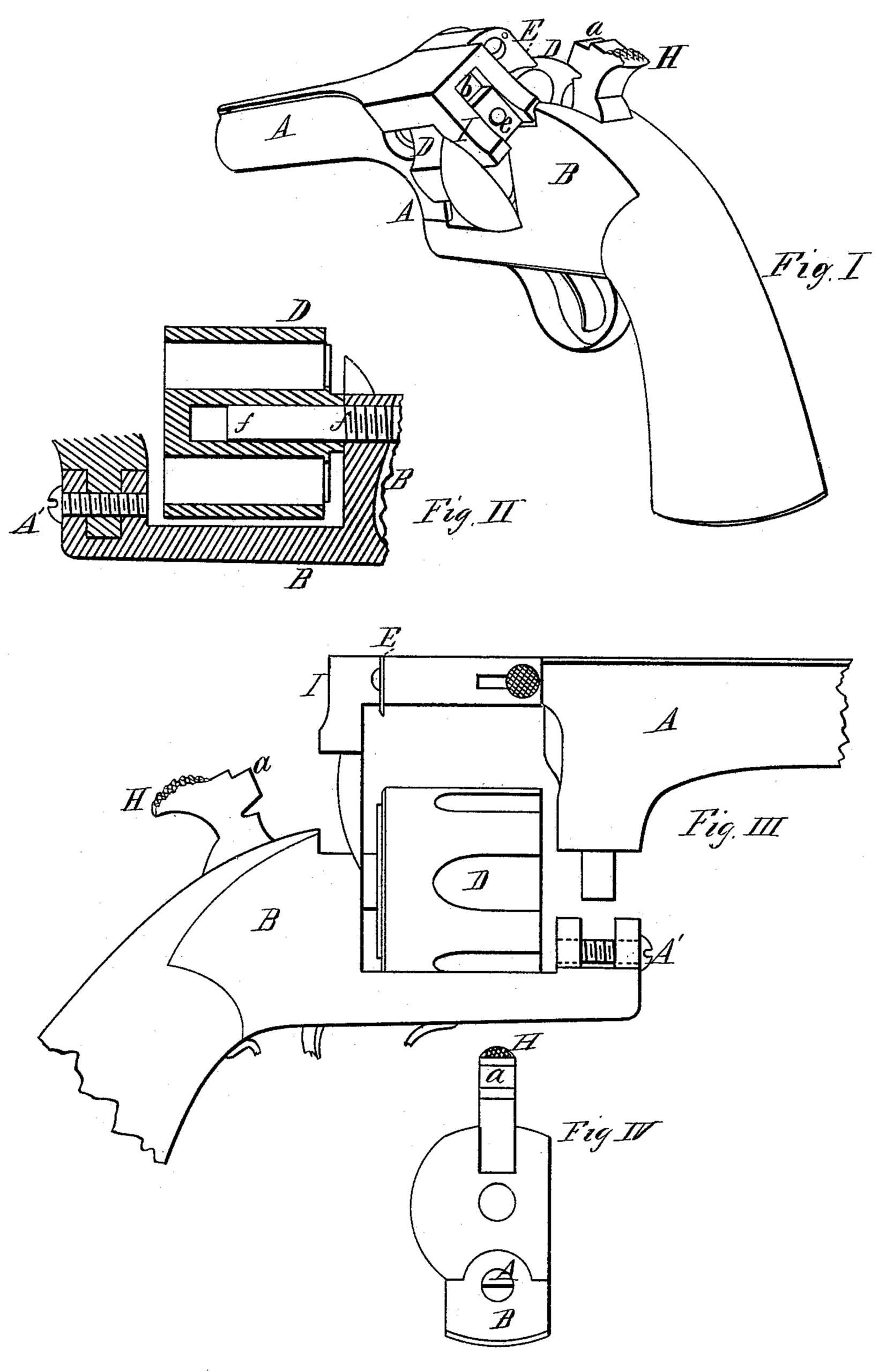US 204335
UNITED STATES PATENT OFFICE.
BENJAMIN F. JOSLYN, OF WORCESTER, ASSIGNOR TO DANIEL B. WESSON,
OF SPRINGFIELD, MASSACHUSETTS.
IMPROVEMENT IN REVOLVING FIRE-ARMS.
Specification forming part of Letters Patent No. 204,335, dated May 28, 1878; application filed April 4, 1878.
To all whom it may concern:
Be it known that I, BENJAMIN F. JOSLYN, of Worcester, in the State of Massachusetts, have invented a new and useful Improvement in Revolving Fire-Arms and that the following is a full, clear, and exact description thereof, reference being had to the accompanying drawings, making a part of this specification, and to the letters of reference marked thereon.
My invention consists of a revolving fire-arm, in which the actual recoil-plate, which receives the recoil of each discharge, is made on the rear end of the barrel, and moves with it, whenever the barrel is moved, to extract the shells, or to insert the cartridges into the chambers; and also in which the cylinder is attached to the lock-frame by, and rotates upon, a base-pin, made permanent in the lock-frame, which pin extends forward into but not through the cylinder, the front portion of the cylinder, in front of the base-pin, being made solid, all of which will be more fully hereinafter described.
Figure I is a perspective view of my invention, showing the barrel and recoil-plate made together, and tilted to one side, as in extracting the shells; and Fig. II is a longitudinal vertical section of so much of the arm as is necessary to show the lock-frame and basepin, made permanent one with the other, and the latter extending forward into but not through the cylinder. Fig. III is a side elevation, showing the barrel detached from the frame; and Fig. IV is a front-view of the frame, with the barrel and cylinder removed.
In the drawings, B is the lock-frame of a revolving fire-arm, having the base-pin f secured permanently thereto, either by means of a screw-thread made on the pin, and turned into a threaded hole in the frame, or by making the pin solid with the frame, or in any other convenient manner; and A is the barrel portion of the arm, attached to the frame by a joint, A’; and I is the recoil-plate, which, when all the parts of the arm are in place, with the chambered cylinder D properly adjusted on the base-pin f, is located just in rear of the chamber which is uppermost and in line with the barrel, and therefore takes all the recoil of the explosion when the arm is discharged.
The firing-pin e, which explodes the cartridge is located in and extends through this recoil-plate I, and the plate has also a recess, b, therein, into which the piece a on the hammer H enters when the latter is down and the barrel is in line with the frame, which looks the barrel and frame together audit will be seen that only when the barrel and frame are in line with each other can the hammer strike the firing-pin and the arm be discharged.
A thin extractor-plate, E, is attached to the rear end of a rod moving in a socket on the side of and parallel with the rear end of the barrel, the flanges of the cartridge-shells passing in rear of the sharp edge of said plate as the cylinder is rotated, and each shell being extracted, as it comes into line with the extractor, by pushing the extractor and its rod to the rear.
When the barrel is tilted to one side on its hinge, the recoil-plate I moves with it, and away from its position in rear of the uppermost chamber of the cylinder, and from in front of the hammer, leaving the space in rear of the upper part of the cylinder open and free for extracting the shells or inserting cartridges into the chambers, as shown in Fig. I.
The central hole in the cylinder D is made from the rear end, but does not extend through it, so that the front end of the cylinder, forward of the base-pin f, is made solid, by which construction the liability of the bearing of the base-pin inside the cylinder to get fouled from dirt from the explosions is very much diminished.
Having thus described my invention, what I claim as new is–
In a revolving fire-arm, the barrel A, having the recoil-plate I made thereon, combined with the lock-frame B, whereby, when the barrel is tilted, the recoil-plate moves with the barrel away from its position in front of the hammer, substantially as described.
BENJAMIN F. JOSLYN.
Witnesses:
T. A. CURTIS,
G. E. BUCKLAND.

